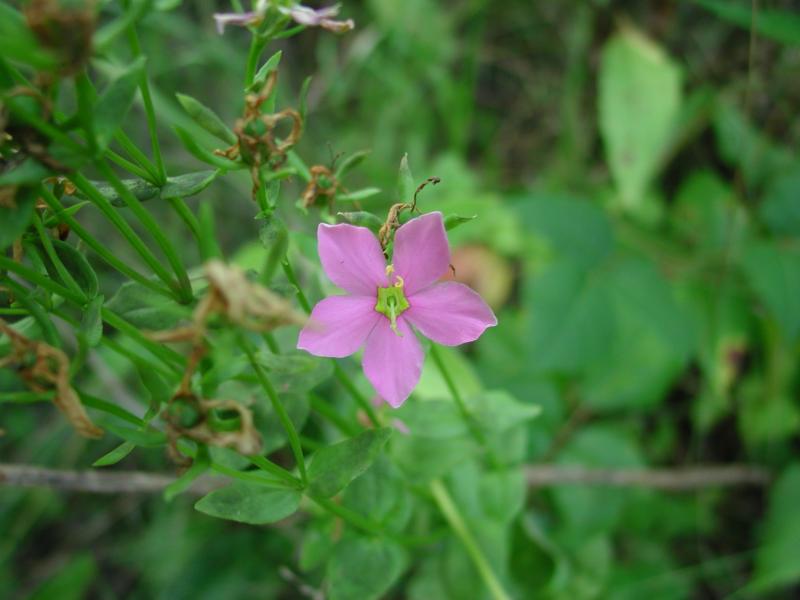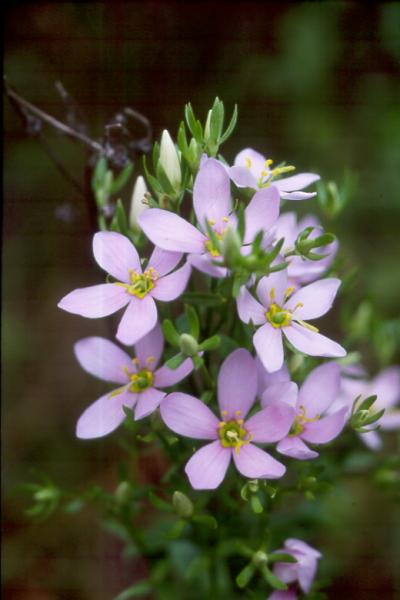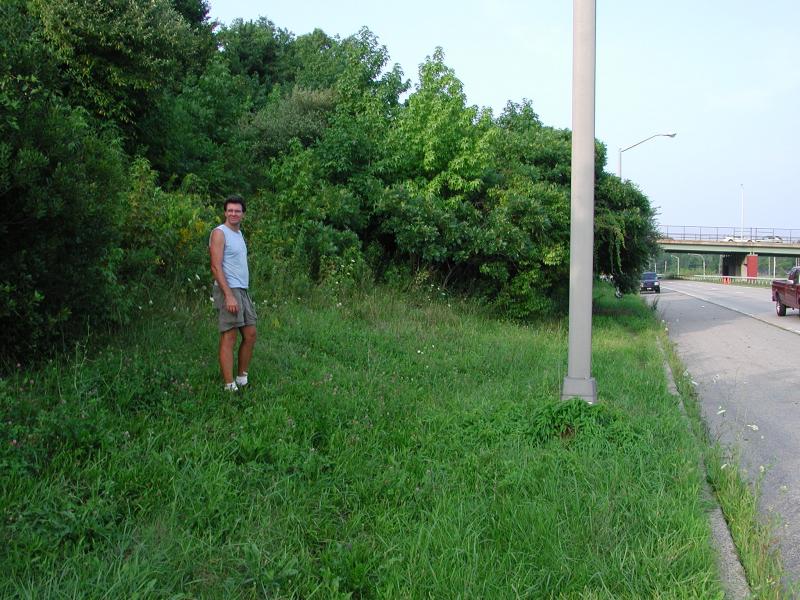Rose Pink
Sabatia angularis (L.) Pursh
- Class
- Dicotyledoneae (Dicots)
- Family
- Gentianaceae (Gentian Family)
- State Protection
- Endangered
Listed as Endangered by New York State: in imminent danger of extirpation in New York. For animals, taking, importation, transportation, or possession is prohibited, except under license or permit. For plants, removal or damage without the consent of the landowner is prohibited.
- Federal Protection
- Not Listed
- State Conservation Status Rank
- S1
Critically Imperiled in New York - Especially vulnerable to disappearing from New York due to extreme rarity or other factors; typically 5 or fewer populations or locations in New York, very few individuals, very restricted range, very few remaining acres (or miles of stream), and/or very steep declines.
- Global Conservation Status Rank
- G5
Secure globally - Common in the world; widespread and abundant (but may be rare in some parts of its range).
Summary
Did you know?
The stem is strongly 4-angled in this species. It was given the name of angularis by Linnaeus to describe this character (Fernald 1950). It is the tallest of any of our Sabatia species.
State Ranking Justification
There are four existing populations but most of them are small with less than 200 plants. They exist in small natural areas surrounded by development and they are not actively managed. There are two historical populations from the turn of the 19th century that need to be rechecked and nine populations that no longer exist because the areas where they occurred have been developed.
Short-term Trends
The short-term trend is negative. Two populations have been resurveyed and their numbers have been reduced in the last 20 years.
Long-term Trends
The long-term trend is negative as most of the known locations of this plant have been destroyed. Only four populations with low numbers of plants remain.
Conservation and Management
Threats
Habitat destruction from residential and commercial development around these populations is a significant threat. Improper management of their meadow habitat by mowing at the wrong time of the year, as well as dumping of trash, are also threats.
Conservation Strategies and Management Practices
Prevent direct human disturbance to the plants while maintaining their open meadow habitat.
Research Needs
Propagation studies should be done to find out if existing populations can be augmented.
Habitat
Habitat
In New York, this species is found in wet human-disturbed openings in successional shrublands and grasslands. All of the populations are along highways (New York Natural Heritage Program 2012). In a wide range of habitats, sometimes weedy (Gleason and Cronquist 1991). Open woods, clearings, prairies and fields (Fernald 1950).
Associated Ecological Communities
- Mowed roadside/pathway
A narrow strip of mowed vegetation along the side of a road, or a mowed pathway through taller vegetation (e.g., meadows, old fields, woodlands, forests), or along utility right-of-way corridors (e.g., power lines, telephone lines, gas pipelines). The vegetation in these mowed strips and paths may be dominated by grasses, sedges, and rushes; or it may be dominated by forbs, vines, and low shrubs that can tolerate infrequent mowing.
- Successional shrubland
A shrubland that occurs on sites that have been cleared (for farming, logging, development, etc.) or otherwise disturbed. This community has at least 50% cover of shrubs.
- Successional southern hardwoods
A hardwood or mixed forest that occurs on sites that have been cleared or otherwise disturbed. Canopy trees are usually relatively young in age (25-50 years old) and signs of earlier forest disturbance are often evident. Characteristic trees and shrubs include any of the following: American elm, slippery elm, white ash, red maple, box elder, silver maple, sassafras, gray birch, hawthorn, eastern red cedar, and choke-cherry.
Associated Species
- Acer rubrum
- Aronia arbutifolia (red chokeberry)
- Betula populifolia (gray birch)
- Carex
- Comptonia peregrina (sweet-fern)
- Eupatorium perfoliatum (boneset)
- Euthamia caroliniana (slender flat-topped-goldenrod)
- Lespedeza repens (creeping bush-clover)
- Lespedeza virginica (slender bush-clover)
- Photinia pyrifolia
- Rhus copallinum
- Salix
- Vaccinium corymbosum (highbush blueberry)
- Viburnum dentatum
Range
New York State Distribution
This wildflower is currently known from Staten Island and considered extirpated from Manhattan, Queens and Westchester counties. There is a historical record from Suffolk County.
Global Distribution
This is a wildflower of the south-central and eastern United States extending north to southern Illinois and east to eastern Pennsylvania, New Jersey and Long Island. It is absent from Eastern Georgia and the peninsula of Florida.
Identification Comments
General Description
Sea-pink is a biennial wildflower that grows 3-8 dm tall. The stems usually have many opposite branches in the upper half and they have sharp, winged angles. The leaves are ovate or lance-ovate, 1-4 cm long and 1.5-3 times as long as wide. They are broadest near the heart-shaped base. The flower pedicels are 5-30 mm long and well developed beyond the uppermost leaves or branches. The conspicuous wings of the pedicels continue to the base of the sepals. The flowers are very light to dark pink with a greenish-yellow center outlined in dark pink. The petal lobes are 1-2 cm long and widest at the top (Gleason and Cronquist 1991).
Identifying Characteristics
Distinguishing characteristics: stem strongly 4-angled; cauline leaves membranaceous, the middle and upper cordate-ovate, clasping, 3-7 nerved; fruiting calyx-tube 1-3 mm long; corolla roseate or white with a yellow eye, with 5 round tipped obovate lobes 1-2 cm long, their yellow basal spots oblong or ovate and entire or slightly lobed. Best life stage for ID: in flower. Characteristics needed to ID: stem with flowers.
Best Life Stage for Proper Identification
This species is best identified when the plant is in flower.
Similar Species
There is no other Sabatia species in New York that look like this. All the other species have different leaves and alternate, not opposite branching.
Best Time to See
Flowers August to early September.
- Flowering
- Fruiting
The time of year you would expect to find Rose Pink flowering and fruiting in New York.
Rose Pink Images
Taxonomy
Rose Pink
Sabatia angularis (L.) Pursh
- Kingdom Plantae
- Phylum Anthophyta
- Class Dicotyledoneae
(Dicots)
- Order Gentianales
- Family Gentianaceae (Gentian Family)
- Order Gentianales
- Class Dicotyledoneae
(Dicots)
- Phylum Anthophyta
Additional Common Names
- Bitterbloom
Additional Resources
Best Identification Reference
Gleason, Henry A. and A. Cronquist. 1991. Manual of Vascular Plants of Northeastern United States and Adjacent Canada. The New York Botanical Garden, Bronx, New York. 910 pp.
Other References
Fernald, M.L. 1950. Gray's manual of botany. 8th edition. D. Van Nostrand, New York. 1632 pp.
Holmgren, Noel. 1998. The Illustrated Companion to Gleason and Cronquist's Manual. Illustrations of the Vascular Plants of Northeastern United States and Adjacent Canada. The New York Botanical Garden, Bronx, New York.
New York Natural Heritage Program. 2010. Biotics database. New York Natural Heritage Program. New York State Department of Environmental Conservation. Albany, NY.
New York Natural Heritage Program. 2024. New York Natural Heritage Program Databases. Albany, NY.
Weldy, T. and D. Werier. 2010. New York flora atlas. [S.M. Landry, K.N. Campbell, and L.D. Mabe (original application development), Florida Center for Community Design and Research http://www.fccdr.usf.edu/. University of South Florida http://www.usf.edu/]. New York Flora Association http://newyork.plantatlas.usf.edu/, Albany, New York
Links
About This Guide
This guide was authored by: Stephen M. Young, Richard M. Ring.
Information for this guide was last updated on: March 7, 2013
Please cite this page as:
New York Natural Heritage Program. 2024.
Online Conservation Guide for
Sabatia angularis.
Available from: https://guides.nynhp.org/rose-pink/.
Accessed July 27, 2024.


